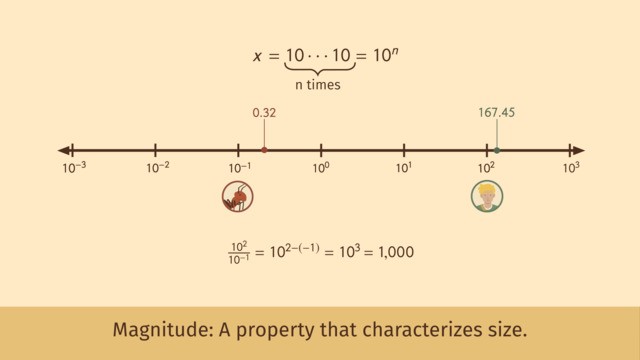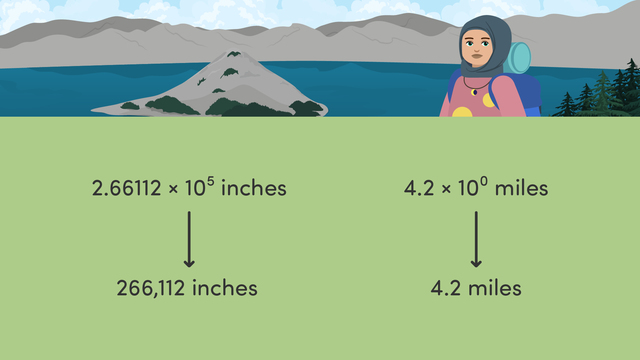Choice of Unit


Basics on the topic Choice of Unit
After this lesson you will be able to determine appropriate units for any measurement, and create new units of measurement, specifically for a situation.
The lesson begins with the criteria you should use to determine which unit is best for any given measurement. This leads to an example where creating a new unit of measurement is necessary.
Learn about choosing units of measurement, by helping Chad on his interplanetary vacation to Earth!
This video includes key concepts, notation, and vocabulary such as: scientific notation (a method of writing numbers in terms of a decimal number between 1 and 10, multiplied by a power of ten); light year (the distance light travels in 1 year); and unit of measurement (a quantity used to express the magnitude of another quantity, such as meters, grams, or degrees).
Before watching this video, you should already be familiar with numbers written in scientific notation and how to convert between units of measurement.
After watching this video, you will be prepared to compare and perform arithmetic operations on numbers written in scientific notation.
Common Core Standard(s) in focus: 8.EE.4 A video intended for math students in the 8th grade Recommended for students who are 13-14 years old
Transcript Choice of Unit
Chad is an extra-terrestrial from a distant galaxy. He wants to visit earth but blending in with earthlings won't be easy. Luckily, Chad has a copy of The Hitchhiker's Holo-Guide to the Earth. It's a crazy collage of all things earthly! Fascinating! Chad learns that in order to fit in, he'll need to make small talk. He learns there are two numerical questions that earthlings are sure to ask. In order to answer with numbers that humans can understand Chad needs to choose his units carefully. Wait! The guide is in Chad's mother tounge. We need to translate it first before we can go on. According to the Holo-guide, the first question Chad will be asked is how far is your home planet from Earth? Chad's planet is called Terranita. Terranita is 5 light-years from Earth. What's a light-year? A light-year is the distance that light travels in one year. But even so, it takes five years for light to travel from Terranita to Earth. How many kilometers is that? One light year is about 9.5 times 10 to the 12th kilometers. So five light years is about 4.7 times 10 to the 13th kilometers. That's 47 trillion kilometers! So which is better? Do you think it's better for Chad to answer that he lives 5 light years from Earth or to answer that he lives 47 trillion kilometers from Earth? Choosing light years as our unit keeps the value reasonable, at 5. And yet, unlike Chad, we earthlings don't experience light-years in our daily lives. Kilometers are units that we humans have everyday experience with. And yet, it can be hard to visualize 47 trillion kilometers, because the number is so large. But Chad has more options. The Holo-guide suggests a new unit to describe this distance. From the Holo-Guide he learns that the Earth's circumference is about 40,000 kilometers. If a human had superpowers and could fly around the Earth once every second it would take about 37 years to travel the equivalent distance to Terranita. The Holo-Guide calls these units flight-years. The distance from Terranita to earth is 37 flight-years. Flight-year has the advantage that it can be visualized. We can visualize a superhuman flying around the Earth once every second, for 37 years. Which unit is best for representing the distance to Chad's planet: light-years, kilometers, or flight-years? Each unit has advantages and disadvantages, and we get to choose the one which we think best expresses the distance in a way we can understand. Perhaps there's an even better unit waiting to be created! Chad now has a few options for units he can use to describe the distance from Terranita to Earth. He'll make a decision when he is face to face with an earthling, and hope for the best! But there is another question he needs to be ready for. According to the Holo-guide, the second question is how heavy is your home planet? Terranita has a mass of 6 trillion kilograms. For a planet, is that large or small? The Holo-guide reveals that our earth is about 6 times 10 to the 24th kilograms! We see that the earth is one trillion Terranitas! One trilllion Terranitas is equivalent to one Earth. We have created two units here, one called Earths, and one called Terranitas. If one Earth is 1 trillion Terranitas then one Terranita is 1 one trillionth of an Earth. One Terranita is a tiny fraction of an Earth. When we expressed Terranitas mass in kilograms it seemed large. But when we expressed it as fractions of Earths, it became clear that Terranita is pretty tiny. Which unit, Terranitas or Earths, will be better to use in small talk with Earthlings? Let's review. We get to choose the best units for communicating a value. We can also create our own units to express a value in a way that we can understand. Like when we expressed the distance to Terranita, we tried known units but we also created a brand-new unit. Chad has lots of options for describing the distance to his home planet and the mass of his home planet. He makes the long journey to Earth. Woah, that landing was less than perfect! But it looks like all the earthlings are ok. Chad is ready to chat with an earthling. But wait a minute, Chad forgot to learn to speak the local language! Even though Chad and the earthling are standing face to face in terms of communication, they are still light-years apart.
















